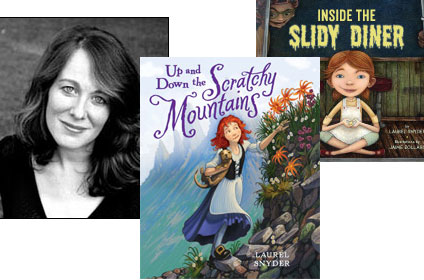Laurel Snyder Is An Old-Fashioned Girl

Laurel Snyder made an appearance on Beatrice earlier this year, when her first book of poems came out. Since then, she’s published two books for children, Up and Down the Scratchy Mountains and Inside the Slidy Diner—and, as this essay reveals, learned some interesting things about her writing in the process.
When I finished writing my first kids’ book, a friend asked to read it. Overall, her comments were positive, and I was pleased. But then she asked me if there wasn’t a way to make the book less sexist. I was surprised at this. It had never occurred to me that the adventures of a defiant little milkmaid would be considered anti-feminist.
But my friend said, “You keep calling Lucy a girl and Wynston a boy. Why do you have to lock them into rigid boxes like that? It’s so conventional.”
I considered this ridiculous, over-the-top feminism. Boys are boys and girls are girls; I ignored her.
But then, when I was revising my second book, my editor had the same kind of comments. “Why does the dad work and the mom stay home?” she asked me. “What is this, 1950?”
And the problem is that yeah, it kind of is—
Because a lot of classic children’s books are set in a “midcentury American” mode. And I write from within that tradition. Those are the books I LOVE! So even if I give my girls attitude, I’m placing them in a universe that replicates what I hope we’re changing in our world.
It’s tricky.
Now I’m beginning a new book. And writing the very first page last night, I ran into my problem again. The little girl in the book—Penny Dreadful—is the daughter of Mr. and Mrs. Dreadful.
Which is funny, since I don’t share my husband’s name and my mother never changed her name. In fact I’m always surprised when people do that now—it seems so conventional, so old fashioned.
But then why do I do this?
Because I’m speaking to the books I admire, which are old fashioned books.
The Dreadfuls are a response—in part—to the Darlings of JM Barrie. If I make Penny a Dreadful, and Mr. Dreadful a Dreadful, but Penny’s mother is a Goldstein, what does that do to my book? Hyphenating and naming them all Dreadful-Goldstein is another option, but Penny Dreadful-Goldstein just doesn’t have the same ring to it.
I consider myself a progressive person. But the women in the books I love—from the nanny-dependent Mrs. Banks of Mary Poppins, to the cartoonish housewives (bearing Jello molds) of Mrs. Piggle Wiggle—are often bad role models. And even the women who rise above their conservative worlds—say, Anne of Green Gables—are still living in a world where those rules apply.
So my challenge is to resist—and somehow infuse my books with the same kind of wit, humor, magic and intelligence—without borrowing the actual conventions of those worlds. But I’m still learning and it takes work to avoid indulgent papas who tousle their children’s heads on the way to work, as well as the assumption that all women want to marry and only little boys like to get filthy.
I know that borrowing the details of classic literature won’t make my books into classic literature. It will only make my books classic-seeming. It’s a cheap trick. So I’m going to try, as I head into my next book, to see these problems as indicators that I need to revise in a deeper way. That I need to really know my characters, and not make them into derivative paper dolls. I think I’ll get there.
But my friend—the one who doesn’t want to segregate kids into rigid divisions like girl and boy—she’s still out of luck.
Because I’m just really old fashioned like that.
2 September 2008 | guest authors |

 Our Endless and Proper Work is my new book with Belt Publishing about starting (and sticking to) a productive writing practice.
Our Endless and Proper Work is my new book with Belt Publishing about starting (and sticking to) a productive writing practice. 
